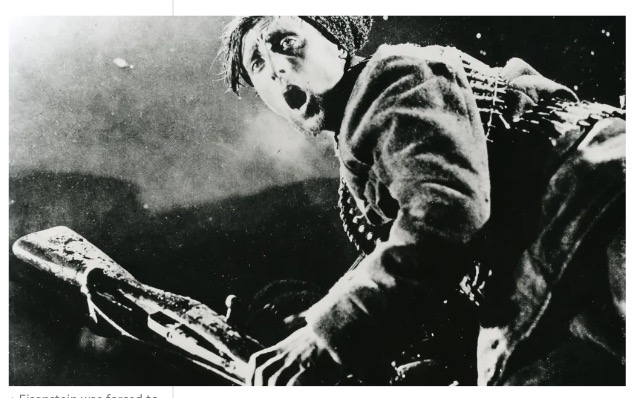PHOTO 200/ PHOTO 375 / ARTH 200 / ARTH 505

========================
** ANNOUNCEMENT: IF YOU ARE USING A DIFFERENT EMAIL THAN ON CUNYFIRST PLEASE EMAIL ME THAT ASAP **
Imaging Resistance:
Photographic Media & Socially Engaged Art
Professor Gregory Sholette <gsholetteSTUDIO@gmail.com>
Office visits take place before or after class: please email me beforehand.
========================
SYNCHRONOUS ONLINE MEETINGS: 6-8PM Monday Eve.
* ZOOM LINK & PASSCODE EMAILED SAME DAY BEFORE CLASS *
The aim of this introductory social theory and photo-imaging survey course is to explore the myriad ways that politically committed image-makers have employed photographic media in support of social justice, community reform movements and political revolutions. Students will gain an understanding of how photo-based imagery became fundamental to diverse societal change campaigns as well as socially engaged art forms over the past 150 years, from the Paris Commune and anti-Nazi photomontage, to Occupy Wall Street, the new Zoom reality of our current Covid world, shared cell-phone documentation of monument take-downs inspired by Black Lives Matter (BLM), and citizen journalists from the USA to Belarus, harassed or arrested simply for photographing police misconduct in public spaces. In addition, we will explore the historical effects of “mechanical representation” on theories of art, culture, aesthetics and identity in the work of writers such as Walter Benjamin, Roland Barthes, Susan Sontag, Allan Sekula, Martha Rosler and The Black Aesthetic Curatorial Collective. Weekly readings and writing assignments, lecture presentations and class discussions, guest speakers and a final research project presentation and paper constitute the requirements, a site visit (virtual) to museums and/or galleries may be scheduled.
We will examine photo-based imagery in printmaking, poster campaigns, street art, culture jamming, tactical media, museum interventions, online media platforms, urban projections and other imaging innovations. Starting with a historical overview of photojournalism during the American Civil War, Crimean War and the Paris Commune, the course goes on to investigate the early European Avant-Garde’s invention of photomontage, followed by the rise of social reform documentary during the Great Depression and then through to modern and post-modern artistic times. Students will gain an understanding of how photo-based imagery is fundamental to diverse socially engaged art forms over the past 150 years, while attending to the complexities and contradictions that underpin this alliance between mechanical imaging and activism. Weekly readings and writing assignments, lecture presentations and class discussions, plus a final research project presentation and paper constitute the requirements for this seminar. There are no pre-requisites for this 3-credit course, occasional site visits to museums and galleries will be scheduled.
GRADE COMPOSITION
· Weekly writing assignments: 30%
· Finab book review paper & presentation: 50 %
· Readings and participation 20%
FINAL BOOK REVIEW due May 17
BOOKS AND ESSAYS TO CONSIDER REVIEWING FOR FINAL
A book review (or review of a long essay review) about socially engaged lens-based art. It must be something other than what we have read in the class. It is due on May 17: BUT A short summary presentation about your review must be scheduled prior to the last day of class (the signup sheet is here: *the SHEETS form will be added later in the semester)
Your review should consist of 1000 – 1500 words (4 – 6 pages max) and accomplish these 4 key objectives: 1.) Summarize what the book/essay is about including what its arguments are and how it relates to our class “imaging resistance” and photographic forms of protest and activism; 2.) How does this particular book contribute to our understanding of the filed of photography (or other lens-based mechanical/digital media) ?; 3.) Does the author(s) achieve what they set out to do and does their argument make sense?; 4.) finally, what is your opinion of the reading? Additional notes: if you quote the author’s words, be sure to add the page number of the citation inside (parentheses). For more details see: BOOK REVIEW GUIDELINES. You do not have to follow them to the letter, however, but treat these as a rule of thumb. Also, please be sure to use the format below for the title of your review:
Title and Subtitle [Upper case and boldface]. Author(s) or Editor(s). Place of Publication: Name of Press, Date. pp.[both Roman and Arabic numerals]; maps, diagrs., ills., notes, bibliog., index [include these as appropriate].
Geographies of Mars: Seeing and Knowing the Red Planet. K. Maria D. Lane. Chicago, IL: University of Chicago Press, 2011. xiii and 266 pp., maps, photos, diagrams, illus., notes, bibliog., index.
Your book/essay review presentation should be only about ten minutes. Sharing images is optional. Mostly, you want to tell the class what the title of the text is, who wrote it and when. Followed by a short synopsis of what it is about, and next some of your reflections, criticisms or perhaps questions that the author raises for you and for us about photography and lens-based imaging in relation to social change and political protest. Signup here: CLICK
A few more notes about the review: You can find many examples of academic book reviews online that will provide a sense of how to approach this project. I suggest accessing JSTOR and use your QC CUNY login credentials to run a search for “book review” plus a subtopic such as “photography “or “photojournalism” or “photographic history” etc…in order to narrow the search.
SAMPLES OF PREVIOUS BOOK REVIEWS ARE HERE CLICK & CLICK
BOOKS AND ESSAYS TO CONSIDER REVIEWING FOR FINAL
==/==
==//==
KEY TOPICS:
1800s: Paris Commune 1871 (early photography and photo publishing)
1936-1939: War Reporting / Spanish Civil War (Robert Cappa & Gerda Taro)
1900-1940 Poverty/Labor (Lewis Hine & Jacob Riis, Workers’ Photo League)
1915(c): Avant-Garde Photo & Film (Rodchenko, Hannah Höch, J. Heartfield)
1900-1950: Anti-Racism and the Photographic Archive USA
1960s: The Situationist International, Paris 1968 & Civil Rights USA
1970s – 1980s: Photo Collectives, Feminism and Visual Activism
1990s -2000s: The Internet, digital imaging, BLM and thereafter
==//==
You may find a book or long essay on your own using these
broad themes as a guideline (though other relevant topics will
also be considered) or choose a text from this list here:
CLICK Here for list of possible books to review.
==//==
Some resources for locating books and essays:
The Queens College Library
Google Scholar
Academia.edu
==//==
==//==
========================
SYLLABUS
** WEEKLY ASSIGNMENTS ARE DUE ON SATURDAY EVE BEFORE CLASS**
A LINK TO YOUR WORK FOLDERS HAS BEEN SENT TO YOU VIA EMAIL
========================
Week 1: Feb 1st – Introduction and overview of the course syllabus and student requirements.
The results of the invention cannot, even remotely, be seen but all experience, in matters of philosophical discovery, teaches us that, in such discovery, it is the unforeseen upon which we must calculate most largely. It is a theorem almost demonstrated that the consequences of any new scientific invention will, at the present day exceed, by very much, the wildest expectations of the most imaginative. ~Edgar Allen Poe, ―The Daguerreotype (1840)
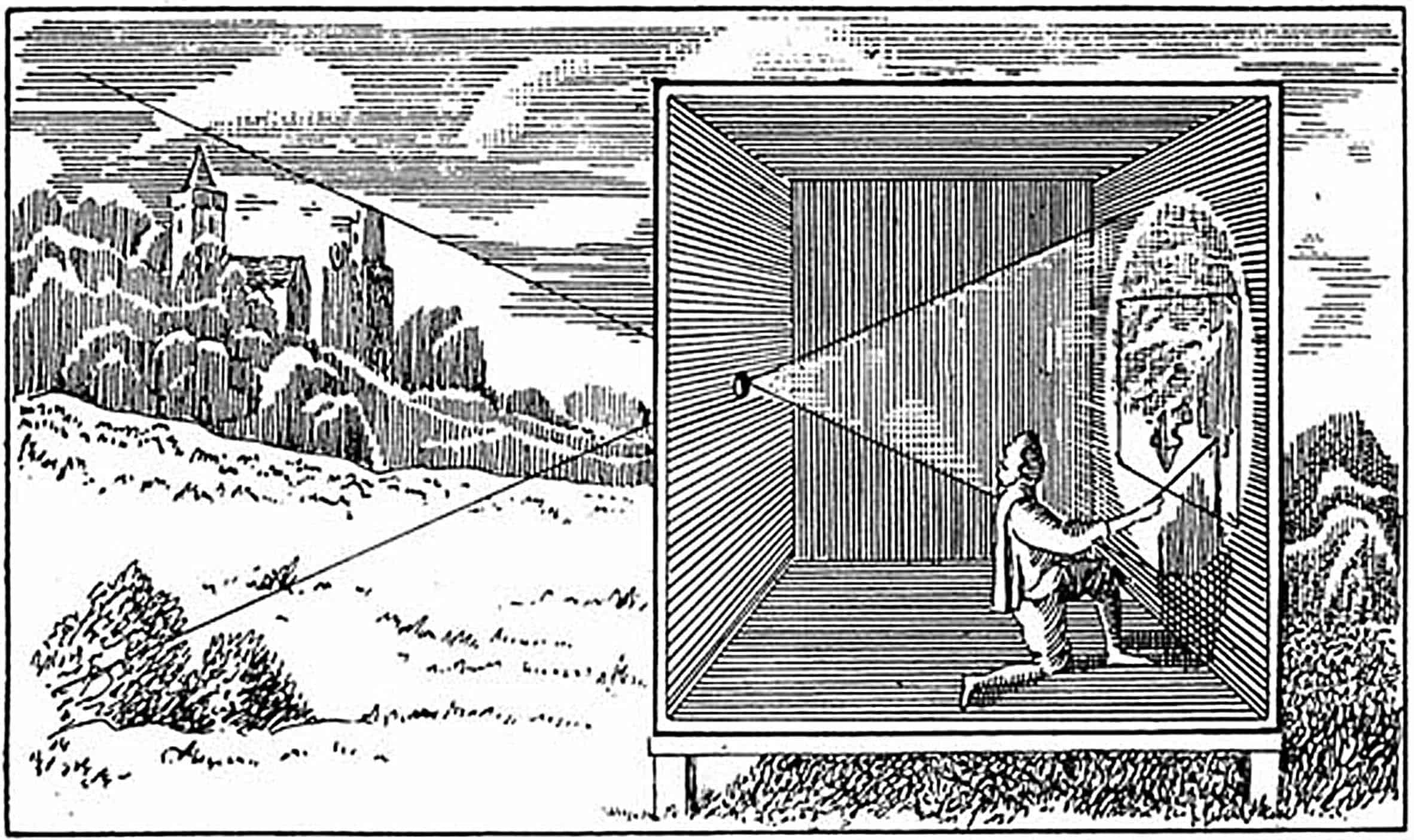
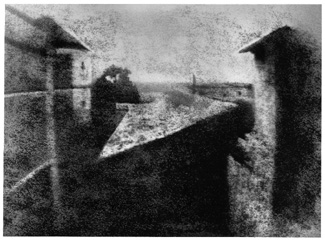
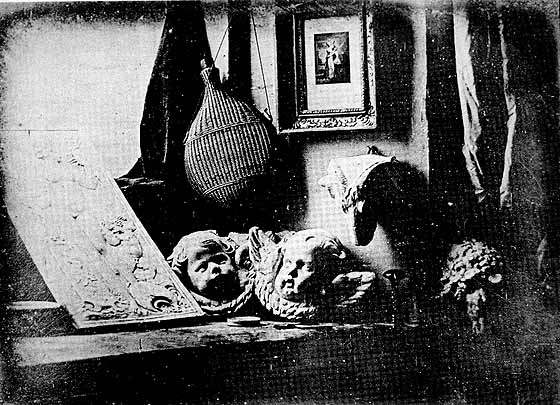

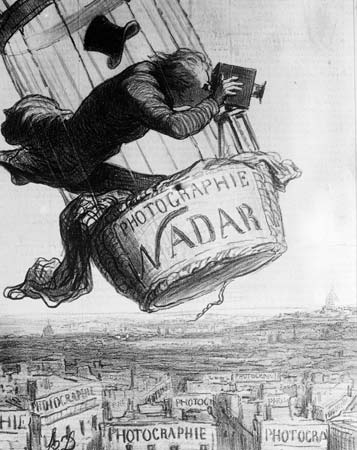
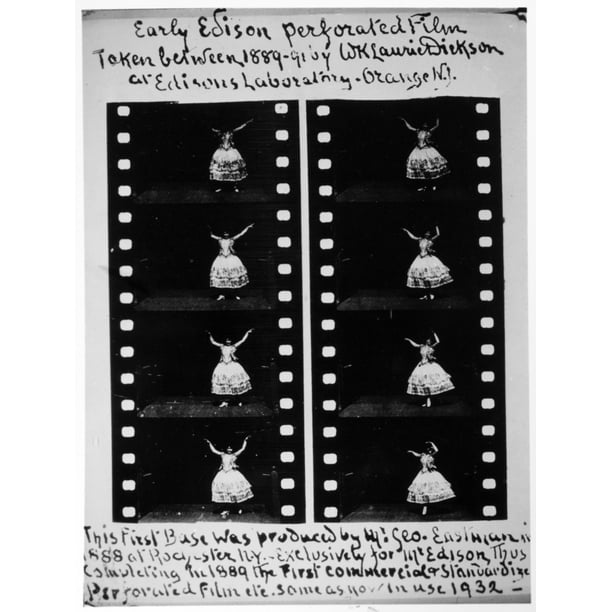
Week 2: Feb 8th- Photographic imagery at the beginning: truth or lies or something new altogether?
READING: Walter Benjamin: “A short history of photography.” (1931):
Additional Optional Reading
Walter Benjamin: “Art in the Age of Mechanical Reproduction” (1935)
Assignment
In no more than 500 Words explain what the author’s point of view about the origin of photography is all about. What is Benjamin’s point about the importance of the photographic caption? What did playwright Bertolt Brecht have to add about photography as documenting the truth (re: The Krupp Factor) ? Why was famous French poet Charles Baudelaire so against photography? (Additional research on your part will be positively reviewed.)
The 400-year old German Krupp Family industries was the largest company in Europe at the beginning of the 20th century, and was the premier weapons manufacturer for Germany in both world wars including the production of battleships, U-boat submarines, tanks, howitzers, guns, utilities, and hundreds of other commodities. The company merged with Thyssen AG in 1999 to ThyssenKrupp AG, a leading global manufacturer of steel construction materials, automotive parts and assemblies, and industrial and mechanical services (but NOT coffee machines).
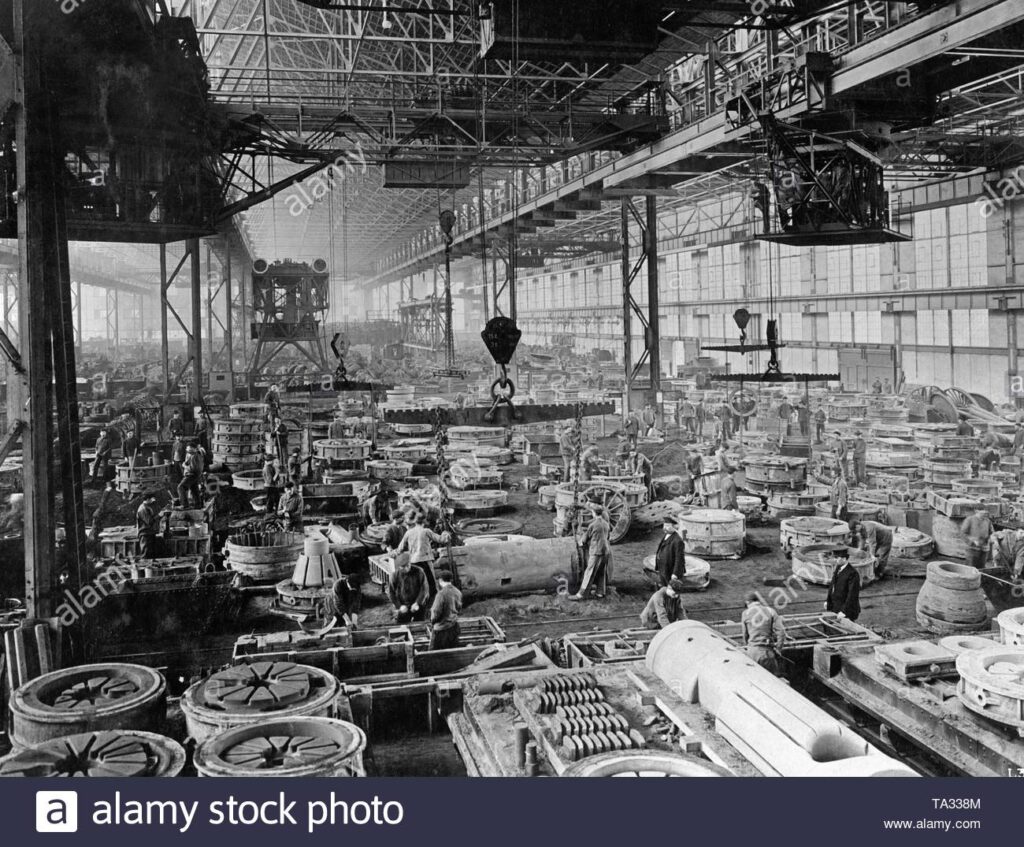
“If photography is allowed to supplement art in some of its functions, it will soon supplant or corrupt it altogether, thanks to the stupidity of the multitude which is its natural ally.’’ Charles Baudelaire, 1859.
Walter Benjamin: “What is aura? A peculiar web of space and time: the unique manifestation of a distance, however near it may be… Today, people have as passionate an inclination to bring things close to themselves or even more to the masses, as to overcome uniqueness in every situation by reproducing it. Every day the need grows more urgent to possess an object in the closest proximity, through a picture or, better, a reproduction. … The prizing of the object from its shell, the destruction of its aura is the mark that the sense of the sameness of things in the world has grown to such an extent that by means of reproduction even the unique is made to yield up its uniqueness.” Short History of Photography, 1931, p 20 1
PDF OF POWERPOINT PRESENTATION ON WB:

A CLAYMATION ADAPTATION OF PLATO’S CAVE ALLEGORY
1.) Plato’s allegory of the cave claymation video: think about how this might relate to both the upside-downness of the camera obscura, and the problem of picturing reality truthfully., and remember the quote by Roland Barthes comparing painting to photography and always knowing that the thing that made the image in the latter had to be there, unlike a painting that could be completely fantastic and made up?
ON BASE & SUPERSTRUCTURE (Marxism 101)
2.) She explains Base & Superstructure in this short video: think about how this idea might apply to our understanding of photo-based image making and its history within society.
ON THE CONCEPT OF REIFICATION (HUMAN RELATIONS AS OBJECTIFIED)
3.) Reification as understood via Marxist theory: think about how this relates to Brecht’s comments on the Krupp Factor image problem.
NO CLASS: MON Feb 15 – Washington’s Birthday: School Closed
Week 3 : Feb 22nd – Imaging the Paris Commune of 1871
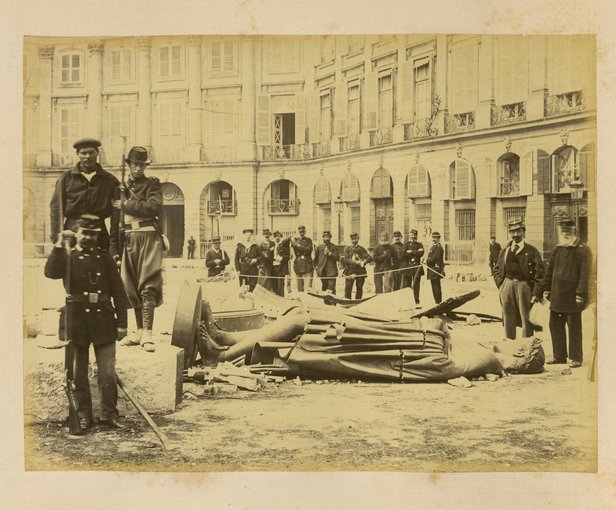
Fixed photographic processes had already been around almost half a century when in 1871 Paris Gustave Courbet and the Communards toppled the Vendôme Column as a protest against the monument’s blatant tribute to militarism. An albumen photograph by Bruno Braquehais shows the demolished monument surrounded by those who brought it down. Braquehais documentation of the Paris Commune is one of the first examples of photojournalism, but authorities later used his photographs to track down, arrest and execute revolutionaries that were represented in his images. Note the irony of this dual use of mechanical representation as it documents, celebrates and disseminates images of radical change on one hand, and then becomes a means of enforcing a police counter-action to such transformations on the other hand. This inherent tension within photographic technology forms a key motif that we will bear in mind as we study the imaging of resistance over the course of the semester.
Readings
Jeannene M. Przyblyski: “Revolution at a Standstill: Photography and the Paris Commune”
Mary Blume: The Paris Commune, by Courbet and the Camera
“We don’t care about May ’68,” read its slogan. “We want 1871.”
150 years since Paris commune (news article) The Guardian
Assignment
In no more than 500 Words compare the photographic coverage of events during the 1871 Paris Commune with the photographic and video coverage of the January 6 2021 Washington DC Capitol siege. Please find relevant news to support your arguments. You may include images as part of your comparison.
Viewings
Excerpts from Karl Marx : The Civil War in France (1871)
“Instead of continuing to be the agent of the Central Government, the police was at once stripped of its political attributes, and turned into the responsible, and at all times revocable, agent of the Commune.” Marx 1871
“The whole of the educational institutions were opened to the people gratuitously, and at the same time cleared of all interference of church and state. Thus, not only was education made accessible to all, but science itself freed from the fetters which class prejudice and governmental force had imposed upon it.” Marx 1871
“The Commune intended to abolish that class property which makes the labor of the many the wealth of the few. It aimed at the expropriation of the expropriators. It wanted to make individual property a truth by transforming the means of production, land, and capital, now chiefly the means of enslaving and exploiting labor, into mere instruments of free and associated labor.” Marx 1871
Week 4: March 1st – Seeing while Black /& imaging others: Working Children / Revolutionary Mexican Woman)
For the next three weeks we will continue to explore the various historical uses of photography as it was both adopted by social reformers and political revolutionaries, but also as photography was itself a revolutionary media that radically transformed the way we create images in the fine arts as well as in popular and amateur culture. 1.) Picking up on our previous discussion about the early use of photojournalism during the Paris Commune of 1871 we will consider the way photographic imagery quickly became a medium of mass dissemination via post cards, magazines, newspapers and newsreels that purported to cover such historic events as the American Civil War, the Mexican Revolution, Frank Capa, Gerda Taro and their documentation of the Civil War in Spain. as well as the investigative documentary expositions of working class and impoverished populations by Lewis Hine, Jacob Riis and the depression era documentarians of the Works Progress Administration. 2.) we will go on to examine the anti-Fascist photomontages of John Heartfield and the photographic experiments of the Russian Avant-Garde, Dadaists and Surrealists.
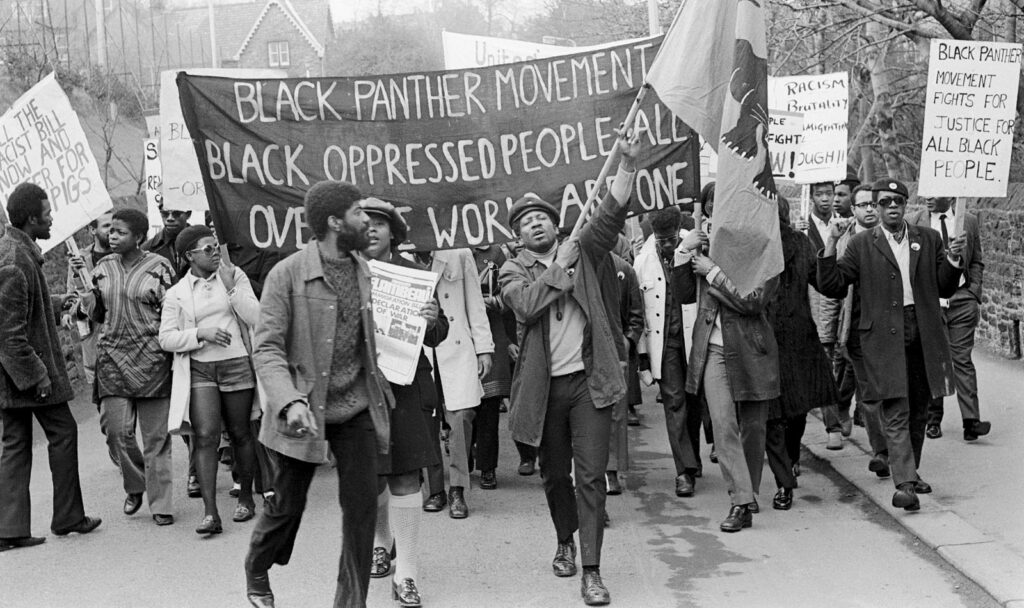
Special Guest Lecture by Maria Quinata
Black Radical Activity and Photographic Networks in Postcolonial London. This presentation will discuss how documentary photography moved through Black-owned print media in the seventies and is part of a larger project that interrogates the ways in which imaginative forms of alliance against anti-Black violence emerged through the simultaneous efflorescence and commingling of Black radical activity and community photography and film in late twentieth-century Britain (1968–1989).
* Special Reading *
Readings
John Mraz Photographing the Mexican Revolution
Russell Campbell: “America: The (Workers’) Film and Photo League”
Additional Reading for Grad Students
Martha Rosler, In, around, and afterthoughts (on documentary photography). 1989.
Assignment
Read and review this weeks materials and in 500 Words or less write a commentary one of these topics: women in photography, children in photography, the mexican revolution in photography, the early years of war photojournalism,
Slide Presentation Mexican Revolution and Photography
Viewings
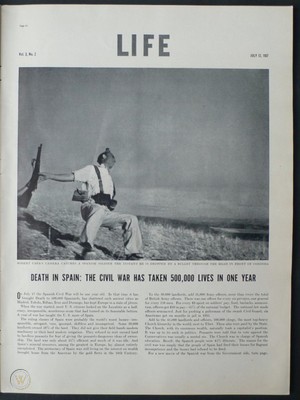
Week 5: March 8 – Photography & the Avant-Garde in Russia (2017 and after)
Readings
Dziga Vertov an Introduction by David Bordwell
Early Soviet Photography Was Surprisingly Avant-Garde
Assignment
Using the historical information from the two readings on Soviet photography, as well as any other sources (such as our class discussions), please argue either for OR against this statement: Does a revolutionary photographic art form also require that the artist is already transformed by revolutionary social events? And what about the audience for these images, does it too require a “revolutionary transformed perception” to be truly understood? *
* Special Reading (not required but related to the question above):
Horacio Legrás, “Seeing Women Photographed in Revolutionary Mexico”
Viewings
Week 6: March 15th: Photography and the European Avant-Garde: DADA
Readings
Sabine Kriebel, “Manufacturing Discontent: John Heartfield’s Mass Medium”
Anna Leung on the art of Hannah Höch: Cut With A Kitchen Knife
Assignment
Upload one to three photomontage images you find online –or that you that create yourself – that are inspired by the photomontage practices of either John Heartfield or Hannah Höch
Viewings
*IMPORTANT NOTE:
Imaging Resistance Photomontage Presentation Oct 5 2020
Mis-Taken Photo History: Storming of the Winter Palace 2017, 2020, 2027
Week 6 / Oct 14: we will discuss final research presentations and papers, making certain each student has a clear topic to work on.
Assignment
Submit your book review choice including these elements: 1.) Title of the book or essay (see details above). 2.) four to six clear and concise sentences about why this is the work you wish to review; 2.) make a comment about your position in relation to the topic of the book or paper.
PART III Socially Engaged Photographic Imagery After Modernism and the Cold War
Over the next four weeks we will explore the ways that contemporary artists and activists utilized photo-imagery and new imaging technologies in their practices especially after 1.) the aftermath of World War II including the US Civil Rights movement and other liberation movements including anti-colonial struggles around the world, as well as environmental justice activism and student opposition to the war in Viet Nam along with the student and worker uprisings of May 1968 in Paris, New York, Mexico, and other nations, 2,) the global political changes that took place after the collapse of actually existing socialism. This shift, in conjunction with the introduction of portable video cameras, high lumen projectors and later cellular, virtual and digital technologies, does not lead photo-based representation into the background away from the world stage, but instead witnesses its explosion across a wide array of media and platforms, and not only in the realm of fine arts, but also within popular and amateur culture and advertising. Indeed, today it is all but impossible to escape mechanical photographic representation as it surrounds us and even inserts itself into portable electronic devices we keep with us on a 24/7 basis. Socially engaged artists have taken notice and made exceptional use of this proliferation of photo-imagery to simultaneously capture and disseminate instances of political dissent, but also to generate new forms of public protest.
Week 7: March 22 – Photography and the Revolutionary Year of 1968 in Paris (and elsewhere)
Reading
Wubin Zhuang, “Putting Pink Man into HIstory: Photography, Art and Politics (2021).
Assignment
Due March 20th (or before sunrise Sunday March 21) : TWO OPTIONS: —————————– 1.) Menou’s analysis of images from Paris in May of 1968 pivots on who gets to control the reading of a photograph. Is it the students and workers on strike, or the State, or the news agencies? Please briefly summarize reading and then find an equivalent tug-of-war over photographic imagery from a contemporary social or political situation and discuss this in relationship to Menou’s critique. ——————————— 2.) Briefly summarize Wubin Zhuang’s essay “Putting Pink Man into History,” and relate his observations to recent events involving the Asian and Asian American and Pacific Asian communities in the United States.
And if you have not yet submitted your book review choice please do so asap
Please be sure to watch the videos and if your engaged with this topic please also look up The Situationist International. Feel free to including external material in your homework, but please be sure to cite these references in a footnote(s).
Viewings
NO CLASS MON MARCH 29: SPRING BREAK 3/27-3/31
Week 8: April 5 – Imaging Women’s Liberation in 1970s UK
Readings
Na’ama Klorman-Eraqi, The Hackney Flashers: Photography as a Socialist Feminist Endeavour
Online Resource: https://hackneyhistory.wordpress.com/2013/06/
Assignment
After completing the reading, please take this online quiz from the Tate Modern in London and write 500 words about the idea of working with others in a collective in the past (1960s-1980s), and how it would be imagined differently today by yourself and your friends.
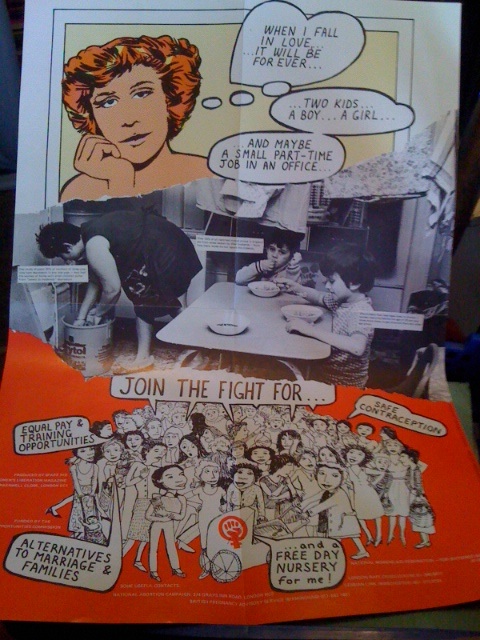
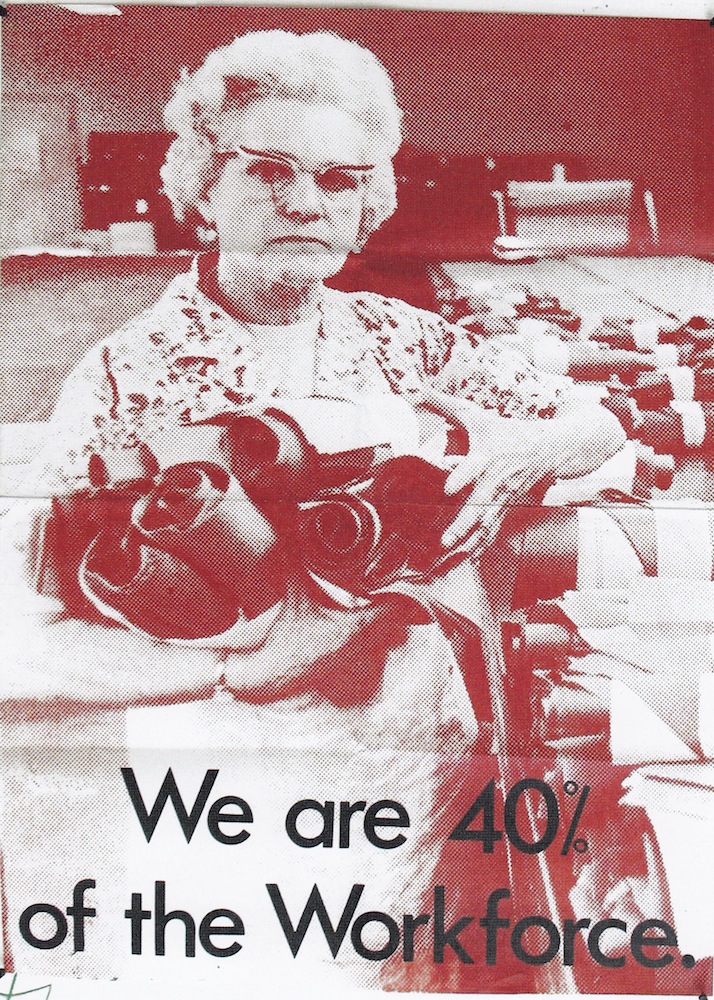
Week 9: April 12 – Imaging Feminist LiPberatiPreon in the 21st Century
Readings
Optional Reading
Eva Diaz. History Is Ours: Protest, revolt, and visual politics
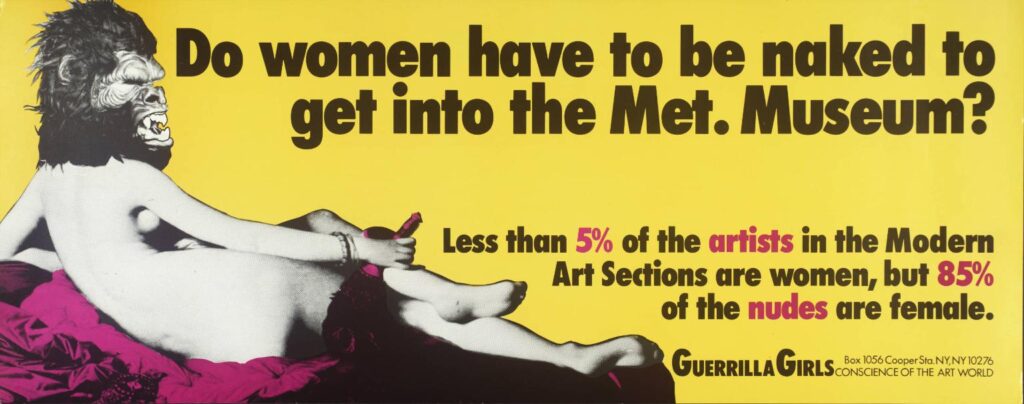
Assignment
Devise a slogan in the style of Guerrilla Girls and (optional) make a poster out of it. You don’t have to address feminism per se, but can focus on any issue you see as important, including education, yours or your students, Covid, the elections or other concerns.
** This semester students will get EXTRA CREDIT FOR VOTING on or before Tuesday November 3. Please email me some evidence that you voted, for example, a selfie with a sticker that says, “I voted”. I realize that everyone in the class might not be eligible to vote. This makes it even more important that the rest of us do. This is the most important election in this country in many, many decades, so be part of the solution. **
Week 10: APRIL 19 – Racial Justice and the Racialized Photographic Archive
Readings
Leigh Raiford, Photography and the Practices of Critical Black Memory
Amy Louise Wood, “We Wanted to be Boosters and Not Knockers”
Assignment
Generate 1 question for class discussion related to essays.
Viewings
========================
========================
Before submitting your book review (end of day Monday May 17) You will make a short presentation following these guidelines:
** Your book/essay review presentation should be only ten minutes long. Read it outloud to someone and time yourself. Sharing images is a good idea though optional. Mostly, you want to tell the class what the title of the text is, who wrote it and when. Followed by a short synopsis of what it is about, and next some of your reflections, criticisms or perhaps questions that the author raises for you and for us about photography and lens-based imaging in relation to social change and political protest. **
April 26, May 3, & May 10– Students will make short – TEN MINUTE – visual presentations on book reviews.
========================
========================
Week 11: April 26 – The Visual Imaginary of Black Lives Matter
Readings
“Photographers are being called on to stop showing protesters’ faces. Should they?”
The First Photos of Enslaved People Raise Many Questions About the Ethics of Viewing
Sarah Lewis, The Racial Bias Built into Photography
Additional Sites / Presentation by Adam Nadel re: “Shirley Girl” color tests
Leader Ladies Project (Chicago Film Society)
How Kodak’s Shirley Cards Set Photography’s Skin-Tone Standard (AUDIO)
I noticed this new label at the MoMA that refers to Black Lives Matter:
Assignment
Generate 1 question for class discussion related to essays.
Viewings
Week 12: May 3 – Syrian Video Activism and “Citizen Journalism”
Readings
For Syrian activists, YouTube is a sword and shield
The Risks of Relying on Citizen Journalists to Cover the War in Syria
Viewings
Additional Optional Readings
An Oral History of Syria’s Citizen Journalism
Video Activists from Aleppo and Raqqa as ‘Modern-Day Kinoks’?
Lara Baladi, When Seeing is Belonging: The Photography of Tahrir
Nayrouz Abu Hatoum, Framing Visual Politics: Photography of the Wall in Palestine
Assignment
If we have time , Please be prepared to discuss and debate “citizen photojournalism” and the lens-based imaging of uprisings and revolutions
========================
========================
MAY 17 – ALL PAPERS DUE END OF DAY!
International Projects & Resources
Yugoslavian Partisan Photography
London Alternative Photo Collective
David Bacon’s documentary photo website
John Heartfield photo gallery (Germany 1930s)
Urban Subjects photo based self-organizing (Germany)
Trevor Paglen: ‘Impossible Objects’ That Reveal a Hidden Power NY Times
Students are not required to turn on their camera, though they must keep their microphones available to be spoken with at all times. Students with documented learning disabilities still need to register with the Office of Student Services and provide us with evidence of such before accommodations are made. CLICK
Queens College CUNY regards acts of academic dishonesty (e.g., plagiarism, cheating on examinations, obtaining unfair advantage, and falsification of records and official documents) as serious offenses against the values of intellectual honesty. The College is committed to enforcing the CUNY Policy on Academic Integrity and will pursue cases of academic dishonesty accordingly.

